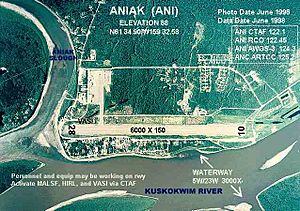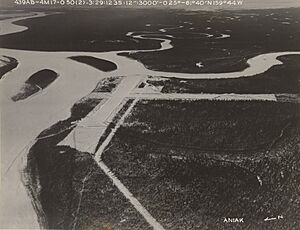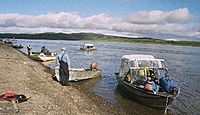Aniak, Alaska facts for kids
Quick facts for kids
Aniak
Anyaraq
|
|
|---|---|

Aerial view of Aniak, 1996
|
|
| Country | United States |
| State | Alaska |
| Census Area | Bethel |
| Incorporated | May 10, 1972 |
| Area | |
| • Total | 8.47 sq mi (21.95 km2) |
| • Land | 6.18 sq mi (16.02 km2) |
| • Water | 2.29 sq mi (5.93 km2) |
| Elevation | 49 ft (15 m) |
| Population
(2020)
|
|
| • Total | 507 |
| • Density | 81.97/sq mi (31.65/km2) |
| Time zone | UTC-9 (Alaska (AKST)) |
| • Summer (DST) | UTC-8 (AKDT) |
| ZIP code |
99557
|
| Area code | 907 |
| FIPS code | 02-03550 |
| GNIS feature ID | 1398286 |
Aniak (pronounced ANN-ee-ak, and called Anyaraq in the Yup'ik language) is a small city in the U.S. state of Alaska. It is located in the Bethel Census Area. In 2020, about 507 people lived there.
Aniak is known for its connection to the Kuskokwim River and its history tied to gold prospecting.
Contents
Geography and Climate in Aniak
61°34′44″N 159°33′1″W / 61.57889°N 159.55028°W Aniak is located on the south bank of the Kuskokwim River. It sits where the Aniak Slough begins, about 59 miles (95 km) southwest of Russian Mission. The city is part of the Yukon-Kuskokwim Delta. It is also about 92 miles (148 km) northeast of Bethel and 317 miles (510 km) west of Anchorage.
The city covers a total area of 8.8 square miles (22.8 square kilometers). About 6.5 square miles (16.8 square kilometers) of this is land, and 2.3 square miles (6.0 square kilometers) is water.
Aniak's Weather Patterns
Aniak has a mix of climates. Summers are influenced by the ocean, while winters are very cold, like a continental climate. Temperatures can range from a very cold -72°F (-58°C) to a warm 92°F (33°C).
On average, Aniak gets about 19 inches (483 mm) of rain and snow each year. Snowfall can be quite heavy, with about 60 inches (1.5 meters) falling annually.
| Climate data for Aniak Airport, Alaska | |||||||||||||
|---|---|---|---|---|---|---|---|---|---|---|---|---|---|
| Month | Jan | Feb | Mar | Apr | May | Jun | Jul | Aug | Sep | Oct | Nov | Dec | Year |
| Record high °F (°C) | 48 (9) |
53 (12) |
50 (10) |
63 (17) |
81 (27) |
92 (33) |
87 (31) |
84 (29) |
75 (24) |
63 (17) |
54 (12) |
46 (8) |
92 (33) |
| Mean daily maximum °F (°C) | 9.7 (−12.4) |
15.4 (−9.2) |
23.3 (−4.8) |
35.2 (1.8) |
51.2 (10.7) |
62.4 (16.9) |
65.2 (18.4) |
60.5 (15.8) |
52.7 (11.5) |
35.3 (1.8) |
21.4 (−5.9) |
9.3 (−12.6) |
36.8 (2.7) |
| Daily mean °F (°C) | 1.2 (−17.1) |
5.9 (−14.5) |
12.6 (−10.8) |
28.1 (−2.2) |
42.4 (5.8) |
52.9 (11.6) |
56.2 (13.4) |
52.9 (11.6) |
44.8 (7.1) |
28.9 (−1.7) |
14.2 (−9.9) |
1.1 (−17.2) |
28.4 (−2.0) |
| Mean daily minimum °F (°C) | −7.3 (−21.8) |
−3.7 (−19.8) |
1.9 (−16.7) |
17.0 (−8.3) |
33.5 (0.8) |
43.3 (6.3) |
47.2 (8.4) |
45.2 (7.3) |
36.8 (2.7) |
22.2 (−5.4) |
7.0 (−13.9) |
−7.1 (−21.7) |
19.7 (−6.8) |
| Record low °F (°C) | −72 (−58) |
−56 (−49) |
−51 (−46) |
−34 (−37) |
−3 (−19) |
28 (−2) |
31 (−1) |
23 (−5) |
5 (−15) |
−17 (−27) |
−40 (−40) |
−55 (−48) |
−72 (−58) |
| Average precipitation inches (mm) | 0.82 (21) |
0.86 (22) |
0.92 (23) |
0.71 (18) |
1.08 (27) |
1.54 (39) |
2.34 (59) |
4.11 (104) |
2.69 (68) |
1.20 (30) |
1.46 (37) |
1.10 (28) |
18.83 (476) |
| Average snowfall inches (cm) | 7.6 (19) |
9.4 (24) |
10.0 (25) |
4.5 (11) |
1.1 (2.8) |
0.0 (0.0) |
0.0 (0.0) |
0.0 (0.0) |
0.0 (0.0) |
3.3 (8.4) |
10.0 (25) |
10.0 (25) |
55.9 (140.2) |
| Source: WRCC | |||||||||||||
Aniak's Population and People
| Historical population | |||
|---|---|---|---|
| Census | Pop. | %± | |
| 1940 | 122 | — | |
| 1950 | 142 | 16.4% | |
| 1960 | 308 | 116.9% | |
| 1970 | 205 | −33.4% | |
| 1980 | 341 | 66.3% | |
| 1990 | 540 | 58.4% | |
| 2000 | 572 | 5.9% | |
| 2010 | 501 | −12.4% | |
| 2020 | 507 | 1.2% | |
| U.S. Decennial Census | |||
Aniak first appeared in the U.S. Census in 1940 as a small, unorganized village. It officially became a city in 1972.
In 2000, there were 572 people living in Aniak. Most households (51.1%) had children under 18 living with them. The average household had about 3.3 people.
The population was made up of different groups: about 68% were Native Americans, 25% were White people, and smaller percentages were Black people, Asian people, or from two or more races. A small number of people were of Hispanic or Latino background.
The median age in Aniak was 28 years old. This means half the people were younger than 28, and half were older. About 41% of the population was under 18.
The History of Aniak
The name Aniak comes from the Yup'ik language. It means "the place where it comes out," referring to where the Aniak River flows into the Kuskokwim River. The original Yup'ik village in this area was empty by the early 1800s when Russian explorers first arrived.
Early Gold Discoveries
In the 1800s, people believed that Russian traders found gold in a river called "Yellow River" in 1832. Many think this was the Aniak River. Later, in 1844, Russian traders found placer gold (gold found in riverbeds) in New York Creek, about 30 miles (48 km) east of Aniak. However, the Russians didn't do much mining.
After the United States bought Alaska in 1867, American prospectors (people who search for valuable minerals) started looking for gold along the Kuskokwim River. It was hard to get to this area, and there were not many trading posts, so mining was limited at first.
Gold Rushes and Growth
The famous Klondike Gold Rush in 1897-98 made many prospectors eager to find new gold. In 1900, a rumor of gold on the "Yellow River" caused many to rush to the Kuskokwim basin. Most didn't find much gold and faced many difficulties.
However, a gold discovery in 1906 near the Innoko River led to another rush. Many prospectors used the Kuskokwim River to get there. This led to more riverboat services and trading posts, which helped increase prospecting activity in the Kuskokwim basin itself.
In 1910, a prospector named "Old Man" Keeler reportedly found gold in the Aniak River basin. In 1911, other prospectors found more gold at Marvel, Fisher, and Dome creeks, about 50 miles (80 km) south of Aniak. Getting to these sites was tough, taking 15 to 20 days by boat.
To make travel easier, a 70-mile (113 km) "cat trail" (a path for tracked vehicles) was built in 1914. It started near Aniak and went to the mining sites. This trail was still used by miners as recently as 2006.
Aniak Becomes a Hub
In 1914, Tom L. Johnson settled at the old Yup'ik village site in Aniak. He opened a store and a post office to serve the miners and prospectors. Soon after, Yup'ik families from Ohagamiut moved to Aniak. A school was opened in 1936.
In 1939, an airfield was built in Aniak. This made Aniak an important transportation center for nearby villages like Chuathbaluk, Kalskag, and Holy Cross.
During the Cold War in 1956, a White Alice Relay Station was built in Aniak. This brought money and jobs to the area and greatly improved communication. In 1957, the first telephone for long-distance calls was installed. Aniak's population more than doubled from 142 people in 1950 to 308 in 1960, showing the big impact of these developments.
Education in Aniak
The Kuspuk School District manages the schools in Aniak. There are two schools:
- Auntie Mary Nicoli Elementary School
- Aniak Jr/Sr High School
Notable residents
- Sam Phillips (Yup'ik), also known as Crow Village Sam (born around 1893, died around 1974), a respected Yup'ik community leader, was born in Aniak.
See also
 In Spanish: Aniak (Alaska) para niños
In Spanish: Aniak (Alaska) para niños




